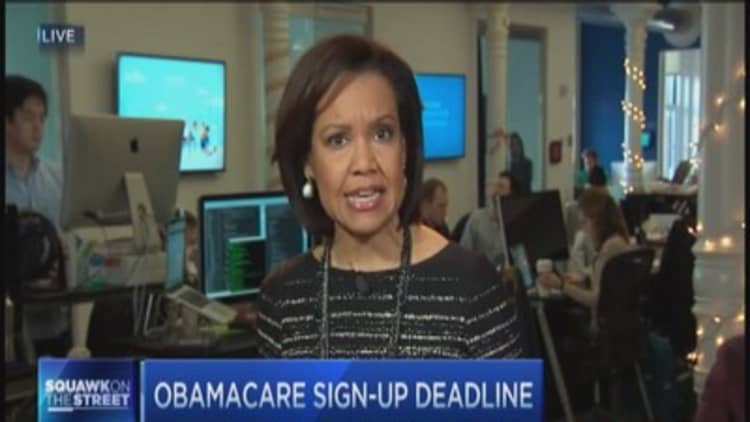While enrollment on government-run Obamacare exchanges gets the bulk of media attention, sign-ups for Medicaid have been even greater, in no small part due to another part of the Affordable Care Act.
Since October 2013, enrollment in Medicaid and the related Children's Health Insurance Program had grown by about 9.7 million people as of this past October, according to data released Thursday by the federal government. That's 17 percent higher than what was the average monthly enrollment level seen from July through September 2013.
That bump brings total enrollment in the programs that provide coverage without a premium charge to the poor and young, respectively, up to 68.5 million people nationally. A bit more than half of those people are children.
Read MoreHealthCare.gov enrollment hits nearly 2.5M
The sharp increase coincides with the October 2013 launch of the Obamacare exchanges, as well as the expansion of eligibility for Medicaid in many states as part of the ACA.
Those exchanges, in certifying peoples' eligibility for coverage for private health plans sold on those marketplaces, direct applicants to Medicaid programs that are jointly run by the federal and state governments if their incomes are low enough to qualify.
At the same time, 26 states and the District of Columbia by October 2014 had expanded eligibility for Medicaid to include nearly all poor adults, in contrast with other states that have less generous eligibility standards and have chosen not to expand.
The Affordable Care Act, as originally written, mandated that all states allow adults who earned below 138 percent of the federal poverty level to enroll in Medicaid. But a 2012 Supreme Court decision said that expansion would have to be left to the discretion of individual states.
"In all of the nonexpansion states except for Wisconsin, childless adults are ineligible for Medicaid, regardless of their incomes," said Jessica Stephens, a Medicaid expert and senior policy analyst with the Kaiser Family Foundation. And even if a person has a child, a number of the expansion states have very low maximum income thresholds for eligibility, including Mississippi, where a parent earning above 27 percent of the federal poverty level, or $5,319, would be ineligible for benefits.
The so-called expansion states saw the biggest boost in Medicaid/CHIP enrollment. Sign-ups there have increased by more than 24 percent compared to just before October 2013, according to data released by the Centers for Medicare and Medicaid Services.
And that agency noted that 11 of those expansion states saw enrollment spikes of more than 30 percent.
Read MoreObamacare's Rainbow Coalition of newly insured
But "states that have not, to date, expanded Medicaid reported an increase of nearly 7 percent over the same time period," CMS said in its report.
The agency does not break out data on how many of the new Medicaid enrollees are people who are newly eligible under the ACA.
However, Stephens and other Medicaid experts have said that enrollment has gone up in part because of the so-called woodworking effect, that has led to previously eligible people signing up for coverage in the program as a result of increased awareness due to the launch of the Obamacare exchanges, and the ACA mandate that most Americans have health insurance or pay a tax penalty.

"But the biggest effect is likely the expansion, the fact that people are eligible now, and you can see that in looking at the data from the expansion states," said Stephens.
Medicaid enrollment, coupled with enrollment in Obamacare exchange-sold private insurance and off-exchange plans has led to a decrease in the uninsured rate in the United States.
Read MoreNavigating the small-biz Obamacare market
The National Health Interview Survey released earlier this week by the National Center for Health Statistics showed that in the second quarter of 2014, there were 11.3 percent of Americans who lacked health insurance, compared to 13.1 percent in the prior quarter, and an average of 14.4 percent in 2013.
The Council of Economic Advisors noted that the 3.1 percentage point drop in the uninsured rate since 2013 "corresponds to 9.7 million Americans gaining health insurance coverage."
However, Stephens noted that the remaining uninsured include people who would currently be eligible for Medicaid, in both expansion and nonexpansion states, who have not enrolled for any number of reasons.
"Continued outreach and effort to reach and enroll people that could be enrolled in Medicaid is important," she said.


